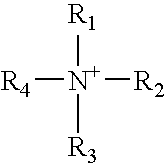High-rate barrier polishing composition
a technology of polishing composition and high-rate, applied in the direction of polishing composition, other chemical processes, aqueous dispersions, etc., can solve the problems of inhibiting its removal, dimensional defects in the circuit interconnect, and attenuation of electrical signals transmitted
- Summary
- Abstract
- Description
- Claims
- Application Information
AI Technical Summary
Benefits of technology
Problems solved by technology
Method used
Image
Examples
example 1
[0068]In this example, we compare the removal rates of Ta, TaN and Cu of four slurries polished on the Strasbaugh 6-EC polisher, as shown in Table 1. The Slurries A and 1 contained 0.50 wt % guanidine hydrochloride in deionized water. Comparative Slurry A did not contain the oxidizer H2O2, while Slurry 1 did contain 0.50% wt. of H2O2. The remaining comparative slurries, Slurries B and C, did not contain any guanidine hydrochloride. Slurry B did not contain H2O2, while Slurry C contained 0.30% wt. of H2O2. The pH level of all slurries was adjusted to 5.0.
[0069]
TABLE 1BTAAbrasiveGHCH2O2TaTaNSlurry(wt %)(wt %)(wt %)(wt %)pH(Å / min)(Å / min)Cu (Å / min)A0.102.000.500.005.0060260120B0.102.000.000.005.00036833C0.102.000.000.305.003510112610.102.000.500.55.007001537107
[0070]The results from comparing Slurries A and 1 show that the combination of guanidine hydrochloride and H2O2 significantly increased the removal rates of Ta and TaN. The comparative Slurries A to C that lacked the combination o...
example 2
[0071]This Example compares removal rates of slurries with the same amount of H2O2 oxidizer, but variable guanidine hydrochloride concentrations and pH levels, as shown in Table 2.
[0072]
TABLE 2BTAAbrasiveGHCH2O2Ta RateTaN RateCu RateSlurry(wt %)(wt %)(wt %)(wt %)pH(Å / min)(Å / min)(Å / min)D0.102.000.000.303.001783228520.102.000.500.303.0059915135830.102.001.000.303.00835146337E0.102.000.000.305.003510112640.102.000.500.305.00530137319050.102.001.000.305.00604162037F0.102.000.000.307.00353414960.102.001.000.307.004261071128
[0073]At each pH level, the increase in guanidine hydrochloride concentration increased the removal rates of Ta and TaN. In addition, the pH level had an impact upon the Ta and TaN removal rates.
example 3
[0074]Table 3 compares removal rates of slurries with the same amount of guanidine hydrochloride concentration of 0.5% wt. at pH 5, but variable concentration of the H2O2 oxidizer.
[0075]
TABLE 3BTAAbrasiveGHCH2O2TaTaN RateCu RateSlurry(wt %)(wt %)(wt %)(wt %)pH(Å / min)(Å / min)(Å / min)G0.102.000.5005.006026012070.102.000.500.35.00530137319080.102.000.500.65.00700153710790.102.000.5025.00551115855410 0.102.000.5045.0045911251390
[0076]The removal rates for both Ta and TaN were functions of the H2O2 concentration. These removal rates have maximum values at about 0.6 wt % H2O2. In addition, the Cu removal rate increases with higher H2O2 concentration. This facilitates selecting a desired Cu removal rate to obtain the required Ta:Cu selectivity. The above examples demonstrate that the removal rates of Ta and TaN are functions of the guanidine hydrochloride concentration, the H2O2 concentration and pH level. Thus, fine-tuning the concentrations of guanidine hydrochloride and H2O2, at any prefe...
PUM
| Property | Measurement | Unit |
|---|---|---|
| pressure | aaaaa | aaaaa |
| weight percent | aaaaa | aaaaa |
| weight percent | aaaaa | aaaaa |
Abstract
Description
Claims
Application Information
 Login to View More
Login to View More - R&D
- Intellectual Property
- Life Sciences
- Materials
- Tech Scout
- Unparalleled Data Quality
- Higher Quality Content
- 60% Fewer Hallucinations
Browse by: Latest US Patents, China's latest patents, Technical Efficacy Thesaurus, Application Domain, Technology Topic, Popular Technical Reports.
© 2025 PatSnap. All rights reserved.Legal|Privacy policy|Modern Slavery Act Transparency Statement|Sitemap|About US| Contact US: help@patsnap.com



